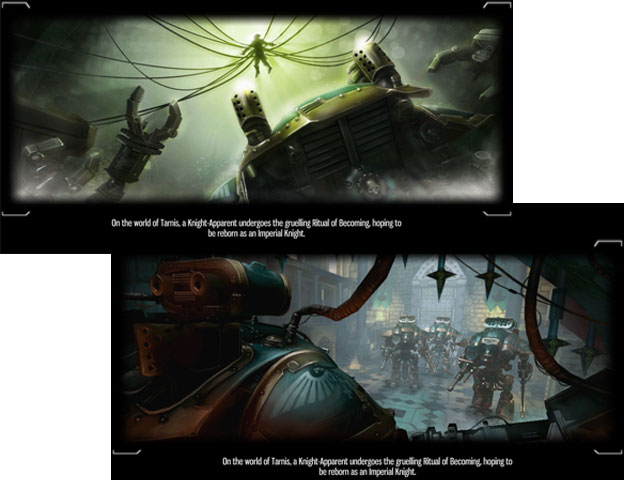
Freeblade was a perfect example of how to design and execute a video game. Those of you that were wondering what were elements of great game design should be taking notes. The story began right in the middle of the action. The audience was placed on the planet of Tarnis where a young Knight-Apparent, the person who would be controlling the gigantic Imperial Knight robot, was undergoing a ritual called the Becoming. This ritual would unite his mind an body with the machine. The choice of words was very important, technological and military organizations in the Warhammer 40,000 universe very often went through ceremonies with religious origins. Except instead of worshipping the traditional figures of Jesus, Buddha or Allah, those in the future were following the Emperor of Terra and the Machine God. The Emperor of Terra was blessed with amazing strength, intelligence and even psychic powers, he was the person that created the Space Marines and helped take humanity across the cosmos circa the year 30,000. He was very much a Christ-like figure for humans in the far future. The life of the Emperor and his accomplishments were spoken of in reverent terms, and in many instances the vehicles and weapons that were used in the future were regarded as holy relics.This bit of framing was by design going back to the roots of the tabletop gaming system itself. I will be speaking at greater length about this relationship in future blogs.
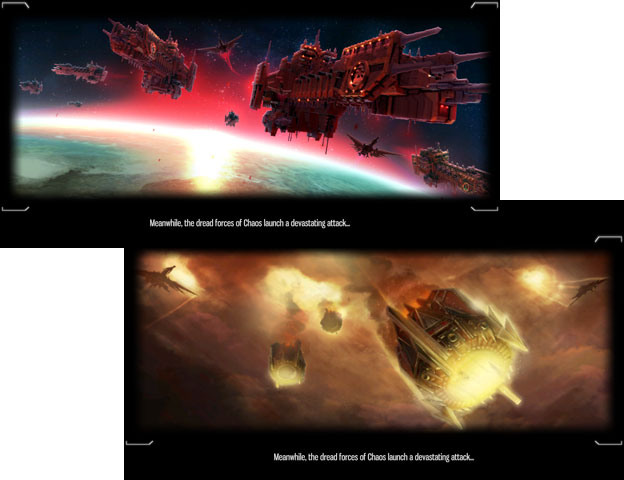
To return to the game however the Knight-Apparent was not simply a pilot in the machine. It was not like he could open a cockpit door and sit in a chair. He was instead becoming one with it, his neural receptors, his biological organs and entire body would be wired directly to the machine. He would be in service to his Emperor until he was completely destroyed. The game didn't waste time explaining how long Tarnis had been around or who the founders were. As the ritual was happening the planet was being besieged by the forces of Chaos. Specifically the followers of Khorne, the blood god, were doing the invading. There were four major Chaos Gods in Warhammer mythology and Khorne was the most violent and bloodthirsty. But again I will talk about the mythology in a future blog. The planet was being invaded undoubtedly for its technology and resources. The forces of evil were sending Chaos Marines, corrupted Space Marines, to the planet surface via Drop Pods. These were weaponized space capsules that allowed troops to be deployed from orbit. These pods landed right on the Imperial headquarters and began all of the action. If you look at the great adventure stories, games and movies you would spot a trend. The best works always started right in the middle of the plot. They did not spend chapters explaining where we were or how we got there, instead we began at the most important moment. Whether it was Star Wars opening with a space battle between the Rebels and the Empire, Harry Potter finding himself aboard the Hogwarts Express, or Kratos throwing himself off of a cliff at the beginning of God of War, the stories that hooked the audience right away were the ones that were remembered. Freeblade had the exact same thing going for it with the invasion. Budding game designers should have noticed that.
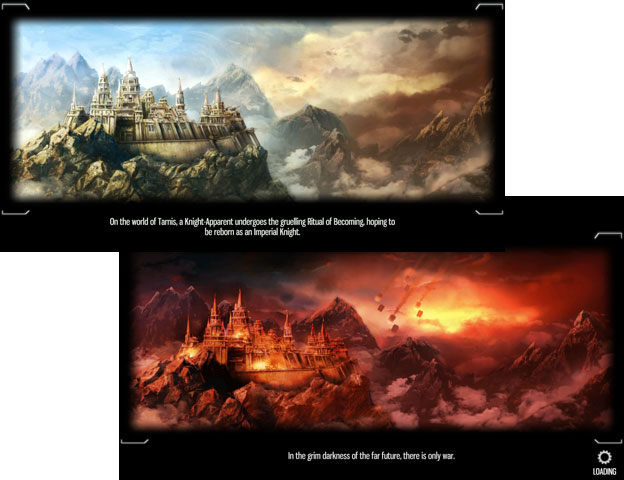
From a game design standpoint the audience had to be willing to pick up the controls and get into the action. There was no time to get settled in the role of Imperial Knight, this meant that there would be no boring tutorial to play through. The audience took control of the robot right away and had to survive a literal "trial by fire." The Knight would be attacked from all sides. Everything from infantry and assault vehicles to gigantic war machines had come in for the kill. Wave, after wave of enemies bombarded the players. The action did not stop from the time the stage started until it ended. That level of tension was a great motivator. It would help establish the type of experience Pixel Toys was trying to create. The player had to learn how to target opponents and manage their weapons as they made their way through the gothic Imperial streets. It was genius game design and something that worked well in the continuity of Warhammer 40,000. Different games required different levels of engagement and this universe required nonstop attention. In the far future there was only war. Humanity was fighting for survival on every planet and every outpost. There was always a sense of urgency in every story and every supplement that Games Workshop released. Billions of lives, an entire population would live or die depending on the outcome of a single conflict. That premise translated very well into a great tabletop and video game experience. That level of urgency had been used by many great action video games since.
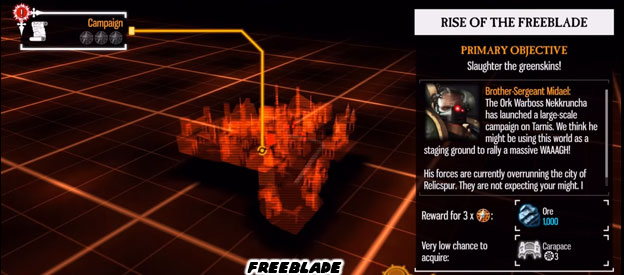
In Freeblade the player would try to recapture or defend the streets of Tarnis from the invaders one block at a time. It was a violent conflict that was completely unlike any shooting game that came before it, including the other Warhammer 40,000 games. In most first person or third-person shooting games the player had to constantly move and look for cover. They had to constantly hunt for weapons and ammo. In this game the Imperial Knight was fully loaded and walking in the dead center of the street. There was no cover as it was wide open to attack. But that exposure worked into the game mechanics. The Imperial Knight was like a tornado, tearing up everything in its path. Small arms fire and even small rockets were like pesky insects to the enormous robot. Characters that were over seven feet tall in canon couldn't even reach the knees of the robot. The player had a sense as to what being a 50-foot tall robot was like. It was an absolute rush. Players did not need to run for cover, they did not need to hide from any opponent. Even the largest tanks could not intimidate the Imperial Knight. If anything the opponents were the ones that had to hide because of the ease of which the a player could demolish a battalion.
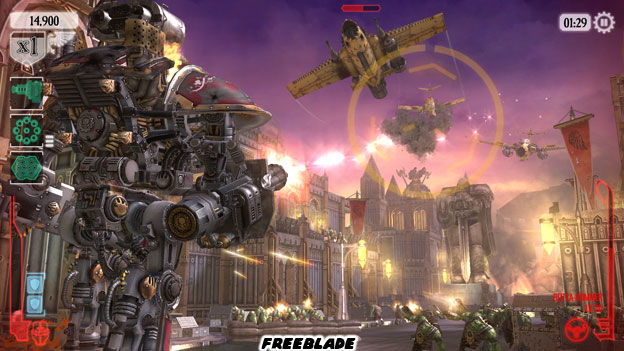
As with any great game or adventure film there had to be a twist added to the story. It would be something that cranked up the tension even more than it already had been. Just as players assumed that the game would be about the Empire versus Chaos, a classic good versus evil plot, it turned out that a different enemy force had also landed on the planet. The brutish Ork's, green skinned monsters with crude weapons, had launched a campaign of their own. Tarnis had become a free-for-all. This was a fantastic plot twist and it happened early in the game. Think about how great books and films also used the exact same device. Star Wars built up to the Emperor, someone with even more power than Darth Vader. Harry Potter built up to Voldemort, someone to be feared more than Severus Snape. God of War built up to Zeus when Ares was assumed to have been the main villain. In Freeblade audiences now had to worry about the tactics and weapons that each type of enemy would use against them. They would have to learn how to react to the differences in technology used by each opponent. Orks for example had weapons that hit hard and fast but weren't necessarily the greatest in the armor department. They might strafe a player from the air or zoom past them on a motorcycle rather than dig in and battle like the Chaos Space Marines. Despite their rough-looking weapons the Orks were engineering savants. They could cobble together a tank or jet fighter with scrap pieces. This meant that they could also build their own giant robot to fight against the Imperial Knight.
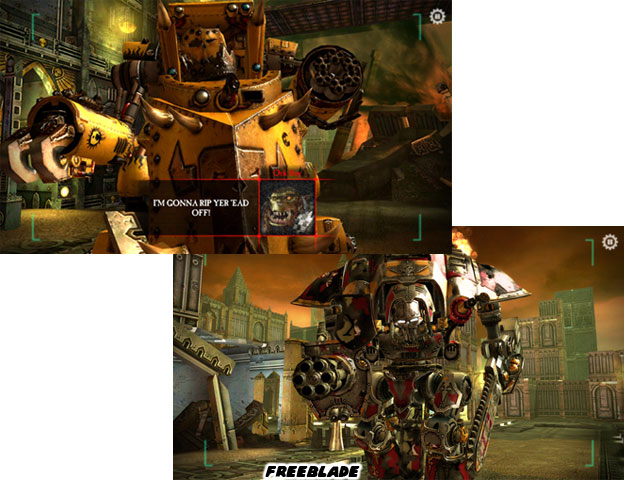
Pixel Toys actually created several different Gorkanaut's, or Ork giant robots, for players to do battle with. Like many of the Ork vehicles, these giant robots were rough around the edges. They had layers of armor plating over a blocky frame. It was a good contrast to the Imperial Knight's regal-yet-functional armor. These crude machines were also strapped with enormous cannons, missiles and melee weapons. The Orks would often unleash a Gorkanaut or two from a side building or blind alley. The giant Ork machines would instantly close off the advancement of the Imperial Knight. Not only that they would charge right at the knight and trigger the melee battle mechanic in the game. This completely changed the way that audiences were experiencing the combat and helped break up the long portions where all they did was point and shoot at targets. During the melee fights the player could not use their long rage weapons, instead they used an enormous chainsword (like a chainsaw arm) to cut the enemy in half.
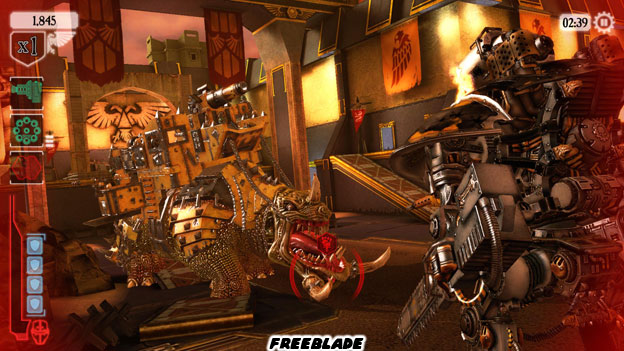
This was not the only oversized weapon that the Orks had at their disposal. They were known for developing weapons out of whatever was available on any planet they invaded. Instead of creating battle tanks the Ork's would sometimes commandeer a giant alien reptile, whose hide was as thick as armor, and place a small fort on its back. These giant alien monsters were better known as Gargantuan Squiggoths. They were often larger than the largest Imperial tanks. The Orks captured the Squiggoths on a far off planet and transported them around the cosmos to be used in all-out assaults. When it came to the actual tabletop gaming system the Gargantuan Squiggoth was a centerpiece in an Ork army. The models were huge, detailed and very pricey. If a player could afford one or more they were usually a veteran gamer with a lot of disposable income as well as time. Yet for younger generals there were also smaller Squiggoths, which were still larger than most artillery pieces. Pixel Toys went to great lengths to capture the look and feel of the 40K universe. I would sometimes miss an opponent because I was too busy looking at the details in the background. The Imperial buildings looked as if they came right off a tabletop campaign. There were statues honoring heroes of the Empire, there were towers and bridges that the player could not only see but also demolish. There were energy plants and ammo dumps that were as vibrant as the ones featured in the pages of White Dwarf magazine, the monthly magazine published by Games Workshop. As the player advanced through the streets we could often see Chaos or Ork soldiers holding a position behind sand bags. We could see them run along rooftops and try to set up positions for rocket-launcher attacks. These warriors would unload from their armored personnel carriers, tanks or drop pods and start shooting at the Imperial Knight. These figures were relatively tiny on the screen and could be picked off like bugs.
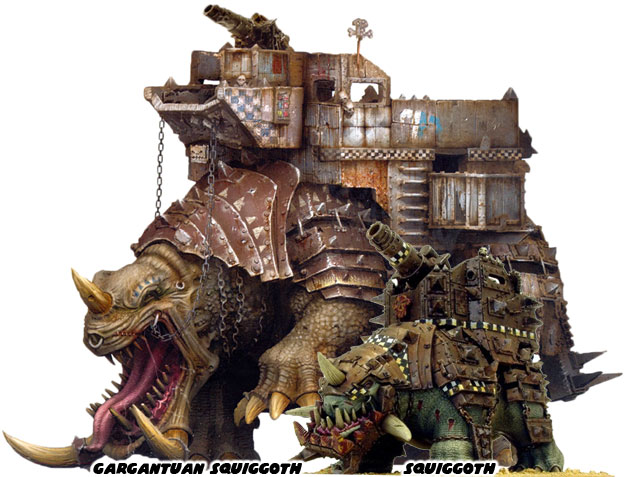
In many stages the player would be joined by Space Marines from the Dark Angels Chapter. As a crossroads a player would actually see a Rhino transport unload the Space Marines and then watch them start fighting opponents on the ground. Sometimes they would storm a building and try to recapture it. Sometimes they could be seen crossing a bridge, or engaged in a firefight on the rooftops as well. Pixel Toys went to the trouble of programming background details that helped bring this world to life. They were putting in the effort you would expect of a AAA console title but into a mobile device. All of the Space Marines were small on the screen but still possessed and amazing amount of detail. They had proper weapons, proper armor and moved exactly as one would imagine the tabletop miniature figures would if they could. Watching the tiny heroes and villains do battle in the background put the entire game in perspective. The majority of Warhammer 40K games, both the tabletop and video game kind, had been told from the point of view of the Space Marine. The Space Marine represented the ultimate human weapon. Thanks to intense genetic modifications (including getting new organs implanted to their biology!) the Space Marines were over seven-feet tall, incredibly strong and resilient to poisons, the elements and injuries. They had to be superhuman soldiers because of how dangerous the alien menace was. The Orks for example were slightly larger and stockier than the Space Marines. In a tabletop game the two sides looked evenly matched. When the figures were placed next to the human-sized Imperial Guard soldiers the contrast was striking. One would imagine that watching the Orks and Space Marines fight in real-life would be fearsome. Yet in Freeblade both sides looked insignificant. The destructive power of the Imperial Knight was simply too much for any humanoid opponent to withstand. Game designers were always searching for ways to make players feel as powerful as the characters they were controlling, Pixel Toys accomplished that many times over. The biggest contribution the studio made was in immersing the player into the world of Warhammer 40K.
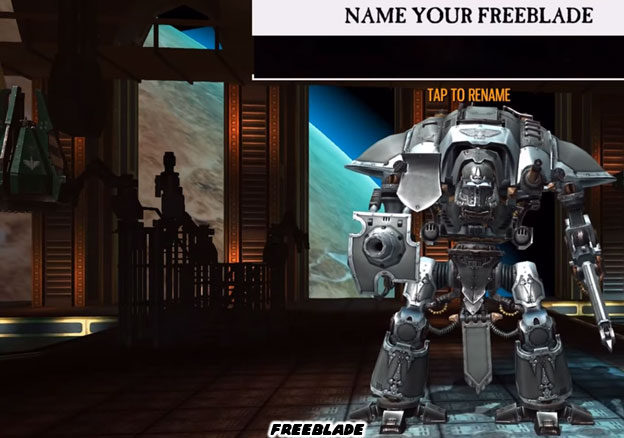
Right after the very first level the player found themselves orbiting Tarnis, aboard the Dark Angels Strike Cruiser: Fist of Caliban. It seemed like a throw-away detail but the menu screen where the player could customize their Knight was all set aboard the ship. In the background the planet Tarnis was slowly rotating, It was the type of eye-candy that science fiction fans longed for. And again, as a long-time fan of Warhammer 40K it was something that I could only imagine what being inside an Imperial Cruiser would have looked like. The studio made sure to convince players that they were in orbit above the home world. As such they could be deployed at any moment to any corner of the planet. While aboard the ship the players learned what their objectives were and watched the story play out. After the initial assault on the planet the gamer discovered that they were the last surviving Imperial Knight from House Drakkus. Lucius Irynblud, the House Sacristan, was the only other surviving member of the initial attack. The Dark Angels, well regarded in the lore of 40K, were the hosts. Brother-Captain Tigraine and Brother-Sergeant Midael would orient the player and give them updates.
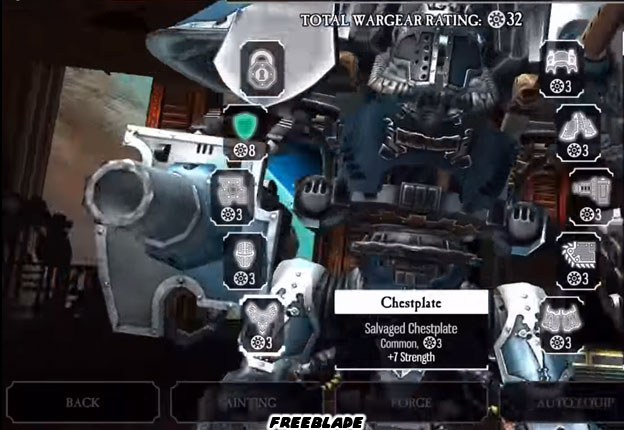
Story, graphics and control aside there had to be a reason for the player to keep coming back. Fans of 40K didn't need much convincing to return again and again. Most players did enjoy the awesome power of shooting at enemies from a giant robot but that experience would get old quick if it were the same each time they played. To mix things up Pixel Toys had daily objectives for the players to fulfill. To keep audiences engaged the players were rewarded for how well they performed in each stage, what secrets they found and even for how accurate they were. Players could upgrade their weapons with items they recovered. Ore that they brought back to the Fist of Caliban could even be forged into stronger weapons and armor. Players could not only customize and upgrade their weapon selection, they could also change the look and color of their Imperial Knight. Again these were details that one might expect in a AAA console title but the fact that it was in a free-to-play game made it all the more impressive.
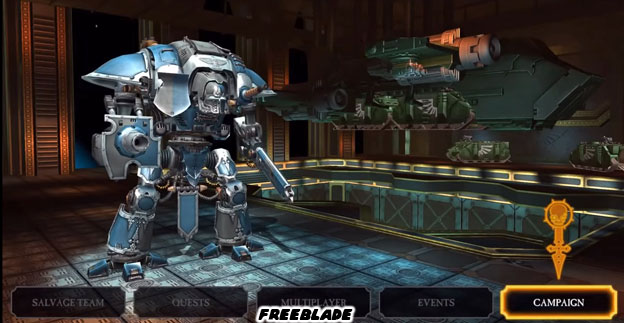
Freeblade could be considered the new standard for mobile games. More than that it was an experience that could have, and perhaps someday might find a home on the new consoles. I hope that outside developers and designers would take a serious look at this title. There was much that even veteran designers could learn by studying it. At the very least they could learn the proper way to handle an IP from Games Workshop. For many years fans of tabletop gaming, and the publishers themselves, felt that the video game would kill the market for hobby systems. Yet decades had passed and tabletop gaming as well as board gaming were still very popular. What many publishers failed to recognize was the importance of video games and how they were an extension of the gaming hobby. A well made video game could serve as an introduction to the tabletop gaming systems. Thanks to games like Freeblade, and the exceptional Warhammer 40,000 Space Marine by Relic Entertainment, the traditional tabletop systems were undergoing a renaissance. Advances in technology benefited everyone in this regard. Freeblade was possibly the best example of this introductory experience because it was free and could be played on a mobile device. Games Workshop had found its best gateway title, but they had actually been at work for several years experimenting with the video game formula. Future blogs will look at how the tabletop systems were adapted for the mobile market, I hope to see you back for those. As always if you enjoyed this blog and would like to sponsor me please visit my Patreon page and consider donating each month, even as little as $1 would help make better blogs and even podcasts!

No comments:
Post a Comment